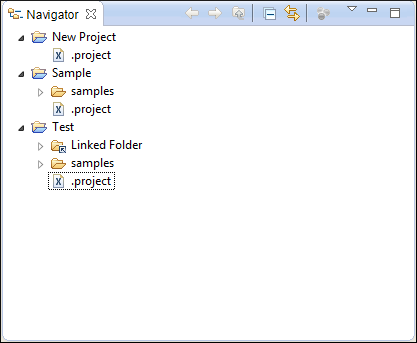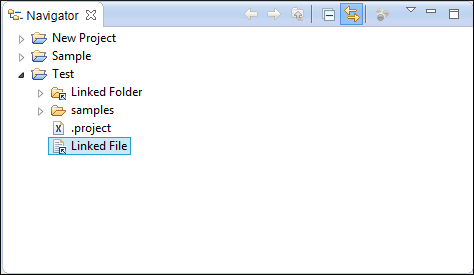Project Explorer View

By default, the view is positioned on the left side of Oxygen XML Author Eclipse plugin, above the Outline view. If the view has been closed, it can be reopened at any time from the menu (the Project Explorer view is in the Other submenu).
Project View Toolbar
 Collapse
All
Collapse
All- Collapses all project tree folders. You can also collapse/expand a project tree folder if you select it and press the Enter key or Left Arrow to collapse and Right Arrow to expand.
 Link with
Editor
Link with
Editor- When selected, the currently edited file (from the main editor or from the DITA Maps Manager view) is highlighted in the project tree, if the file is found in the project.
- View Menu
- Drop-down menu that contains various settings contributed by the Eclipse plugin.
File Explorer Area
The rest of the view is basically a file explorer similar to most other commonly used file explorers. The XML project (.xpr file) is a logical container with a collection of resources (folders and files). The types of resources displayed include:
- Logical folders with Linked folders/files - This folder type is used as containers for linked resources
(shortcuts). The icons for file shortcuts include a shortcut symbol (
 ). The linked folders/files are added using or , or by dragging and dropping files/folders from the view or the
system file explorer.
). The linked folders/files are added using or , or by dragging and dropping files/folders from the view or the
system file explorer.  Delete can be used to remove them
from the project.
Delete can be used to remove them
from the project. - Physical folders and files - Marked with the operating
system-specific icon for folders (usually a yellow icon on Windows and a blue icon on
macOS). These folders and files are mirrors of real folders or files that exist in the
local file system. They are created or added to the project by using contextual menu
actions (such as , ,
 Copy, and
Copy, and
 Paste) or by dragging and
dropping files/folders from the view or the system file explorer. Also, the contextual
menu action
Paste) or by dragging and
dropping files/folders from the view or the system file explorer. Also, the contextual
menu action  Delete can be used to
remove them from the project and local file system.
Delete can be used to
remove them from the project and local file system.

Creating New Projects
- XML Project
- Opens the New XML Project dialog box that allows you to create a new project and adds it to the project structure in the Project Explorer view.
- Sample XML Project
- Opens the New sample XML project dialog box that allows you to customize sample resources in a new project and adds it to the project structure in the Project Explorer view.
Managing Project Contents
There are various contextual menu actions, shortcuts, and ways to organize the folders and files inside the project:
- Creating New Folders and Files
-
- Opens a New Document Wizard that helps you create a new file and adds it to the project structure.
- Opens a wizard where you can create a new document based on a template and adds it to the project structure.
- Opens a New Folder dialog box that allows you to specify a name for a new folder and adds it to the structure of the project.
- Adding Resources
-
You can add resources by using drag and drop (or
 Copy and
Copy and
 Paste) actions from
within the Project
Explorer view or dragging them from the system file explorer. Files
may have multiple instances within the folder system, but cannot appear twice within
the same folder.
Paste) actions from
within the Project
Explorer view or dragging them from the system file explorer. Files
may have multiple instances within the folder system, but cannot appear twice within
the same folder. - Removing Folders and Files
-
To remove logical folders or the linked resources inside them from the project, use
 Delete from
the contextual menu (or press Delete on
your keyboard) and
confirm by clicking OK in the resulting dialog
box.
Delete from
the contextual menu (or press Delete on
your keyboard) and
confirm by clicking OK in the resulting dialog
box.To remove folders or files from both the project and the local file system, use
 Delete from the contextual menu (or press
Delete on your keyboard) and
confirm by clicking OK in the resulting dialog
box.
Delete from the contextual menu (or press
Delete on your keyboard) and
confirm by clicking OK in the resulting dialog
box. - Moving Folders and Files
-
You can move the resources by using drag and drop actions from within the Project Explorer view.
You can also use the usual
 Copy and
Copy and
 Paste actions (or the
Move action) from the contextual menu to move resources
in the project.You can also move certain types of files (such as XML) or folders by using the action from the contextual menu. This action opens the Move resource dialog box that includes the following options:
Paste actions (or the
Move action) from the contextual menu to move resources
in the project.You can also move certain types of files (such as XML) or folders by using the action from the contextual menu. This action opens the Move resource dialog box that includes the following options:- Destination - Presents the path to the current location of the resource you want to move and gives you the option to introduce a new location.
- New name - Presents the current name of the moved resource and gives you the option to change it.
- Update references of the moved
resource(s) - Select this option to update the references to the
resource you are moving, based upon the selected scope. You can select or
configure the scope by using the
 button.
button.
- Renaming Folders and Files
-
There are several ways to rename a folder or file in the project (this works for both physical and linked resources):
- Select Rename from the contextual menu.
- Press F2 on your keyboard.
You also can rename certain types of files (such as XML) or folders by using the action from the contextual menu. This action opens the Rename resource dialog box that includes the following options:- New name - Presents the current name of the edited resource and allows you to modify it.
- Update references of the renamed
resource - Select this option to update the references to the
resource you are renaming. You can select or configure the scope by using the
 button.
button.
- Opening Files
- There are several ways to open a file:
- Double-click the file.
- Select it and press Enter on your keyboard.
- Right-click the file and select Open.
- Drag the file from the project tree and drop it in the editor area.
- If you want to choose the application or location where to open it, you can right-click the file and select Open with.
- Saving the Project
- The project file is automatically saved every time the content of the Project Explorer view is saved or modified by actions such as adding or removing files and drag and drop.

 File
File New from
Templates
New from
Templates Folder
Folder XML
Refactoring
XML
Refactoring XPath in
Files
XPath in
Files Check
Spelling in Files
Check
Spelling in Files Format and
Indent Files
Format and
Indent Files Apply Transformation
Scenario(s)
Apply Transformation
Scenario(s) Configure
Transformation Scenario(s)
Configure
Transformation Scenario(s) Check
Well-Formedness
Check
Well-Formedness Validate
Validate Configure
Validation Scenario(s)
Configure
Validation Scenario(s) Clear Validation
Markers
Clear Validation
Markers Properties
Properties Detect
Main Files
Detect
Main Files Add to Main
Files
Add to Main
Files